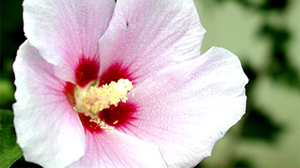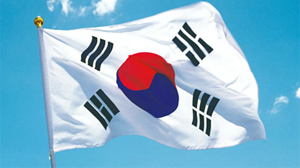EMBLEM AND SYMBOL
Rose of Sharon and the Taegeuk Symbol - the Emblem of the Republic of Korea
The emblem of the Republic of Korea consists of taegeuk, the symbol of yin and yang, and the Rose of Sharon, which is widely accepted as the national flower of Korea.

Even though it has not been made official by law, the Rose of Sharon has been popular among Koreans since ancient times and became the national flower as a matter of course.
The Rose of Sharon blooms during the day and withers after sunset. This trait of the Rose of Sharon represents the vanity of fleeting pleasures as well as worldly wealth and fame. It also signifies a transient life that disappears in a split second throughout infinite time. Ironically, it awakens people to the importance of doing the best at every moment and remaining humble. Despite the ephemeral nature of the blossoms, a Rose of Sharon bush brings forth flowers unceasingly, symbolizing eternity and enduring prosperity.
The taegeuk visualizes the original state of the universe before it was divided into yin and yang, the opposite forces in nature.

It signifies chaotic and amorphous conditions before the beginning of the world, which is a common factor in all myths of creation, as well as the darkness and chaos before the division into heaven and earth.
It is the root of all the myriad forms of the universe and the source of human life, indicating truth. In addition, the taegeuk is the symbol of salvation that can never go extinct. The emblem of the Republic of Korea is currently used on official documents for foreign countries, various medals and citations, various medals and citations, government IDs for civil servants and a variety of certificates of national and public universities.
The Republic of Korea Phoenix, Symbol of the President
Separately from the emblem of the Republic of Korea, there is also a phoenix emblem representing the status and authority of the President.

As an auspicious, mythological bird in ancient China, the phoenix was known to appear at the time of a sage’s birth.
As an imaginary bird, which is referred to as Fenghuang in Chinese, the males are called Feng and the females Huang.
As the virtues represented by the bird are the very values a king had to pursue in governing the people, the design of phoenix was attached on the ceiling of the throne hall of Gyeongbokgung palace, which was the main palace during much of the Joseon Kingdom (1392-1910). The design of the phoenix is still used as the emblem that represents the President of Korea. The phoenix is known to have various features of ten different animals. Its appearance from the front is like a wild goose; the appearance from behind a qilin; the chin a swallow; the beak a rooster; the neck a snake; the tail a fish; the forehead a crane; the cheek a mandarin duck; the pattern on the body a dragon and the back a turtle. Its feathers have five different colors, including red, blue, yellow, white and black.
The features of the above-mentioned ten animals are closely connected to the ten virtues a king is required to have. A wild goose refers to a man of great character who regards faith between a king and subjects, between friends and between a husband and wife as precious as life. A qilin, which was known to have appeared at the birth of Confucius, symbolizes a sage complete with wisdom and talent. As a symbol of a celestial nymph and a woman of noble birth, a swallow represents the talent to make rain, wealth and longevity.
As the first animal to sense when the darkness of night lifts to give way to dawn, the rooster represents magical power to chase away evil spirits and attract good spirits. The snake symbolizes a rich harvest and fertility. The fish is regarded as a symbol of military power because it sleeps with its eyes open, has scales that resemble a general’s armor and travels in tight schools like soldiers in formation.
The crane, believed to be among the Earth’s oldest known bird species, symbolizes nobility, virtue and longevity. The mandarin duck, a traditional symbol of a happy marriage, highlights the importance of family harmony as the foundation for the progress of society and state.
The dragon is a symbol for the most exceptional of people, depicted with five toes when representing the king, with four when representing feudal lords and with three when representing high state councillors. The turtle, associated with the element water, embodies protection against fire as well as longevity and the gift of foresight.
These attributes represented in the physical appearance of the phoenix correspond closely to the qualities that were expected of the king. It can be said that these same virtues are similarly called for in the President today.
The five colors of the phoenix feathers (yellow, blue, white, red, and black) form a traditional Korean color scheme called obangsaek that has its roots in the philosophy of yin and yang as well as the five elements.
Each color corresponds to a cardinal direction, with yellow the color for the center: blue represents east, white west, red south, and black north.



 INTERNATIONAL
INTERNATIONAL